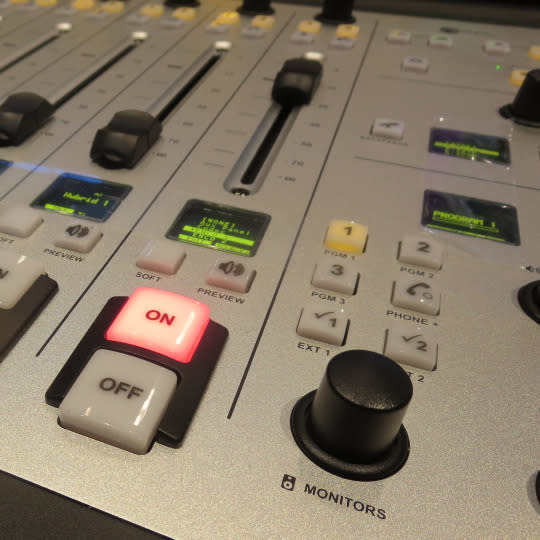Low-Power FM: When Your Local Radio Station Is Really, Really Local

(Photos by Rob Pegoraro/Yahoo Tech)
The most unlikely thing in radio came to Washington DC-area airwaves earlier this month: a new FM station on a previously unused frequency.
A “No Vacancy” sign has been up on the radio dial for decades — to launch a new station, you’d normally need to silence an old one. So how could a new broadcaster like Arlington, Virginia’s WERA (96.7 FM) get its own slice of the airwaves?
It quite literally took an act of Congress. The Local Community Radio Act of 2010 authorized the Federal Communications Commission to license thousands of new ”low-power FM” (LPFM) stations, by relaxing older rules meant to defend the reception of existing stations.
LPFM was meant as a counter to unlicensed “pirate radio” and as an antidote to the wave of consolidation that had left Clear Channel owning an unhealthy chunk of the nation’s stations. Low-power stations max out at 100 watts — a thousandth of the maximum for commercial FM — and can be neither for-profit nor owned by existing broadcasters.

Indie sounds from indie stations
The return of free-form radio
The most memorable sound of LPFM on WERA’s opening night was a cover of Woody Guthrie’s “This Land Is Your Land” that volunteers had performed earlier that day in a studio of its parent organization Arlington Independent Media.
The station has since served up a free-form mashup of music that you almost never hear on commercial FM. One DJ with his medium on his mind followed R.E.M.’s “Radio Free Europe” with Donna Summer’s disco hit “On the Radio” and Rush’s “The Spirit of Radio,” but the selection has also extended to French chanteuse Edith Piaf and 1950s mambo king Pérez Prado.
While WERA continues to boot up, approving shows and training its members, much of its hours are filled with a stream of music cued up in advance. The eventual plan, executive director Paul LeValley said before the station’s opening, is to have a roughly 50-50 split between talk and music.
“The biggest challenge for us is getting the programming going,” he said. “These stations are like black holes, you know — you have to feed them constantly.”
Because WERA only broadcasts at 21 watts, I can outdrive its signal in as little as 15 minutes. But it can still reach a decent chunk of Washington, D.C.
All of this may make LPFM sound like the ultimate hipster taunt: You probably haven’t heard of it and you probably can’t even tune it in. But these stations — 1,430 on the air, by the FCC’s latest count — do more than let aging Generation-Xers like me relive college-radio memories.
The variety of LPFM stations catalogued at sites like the Prometheus Radio Project and Radio Survivor is fascinating. There’s a station for the Twin Cities’ Somali community, one for migrant farmworkers in southern New Jersey, and another one run mostly by Maui teenagers.

The future of LPFM
More than a thousand other LPFM stations are on the way — including a WKRP, although that one’s in Raleigh instead of Cincinnati. But had a long-running debate gone another way, they wouldn’t have been possible.
President Obama’s signing of the Local Community Radio Act only came after a dozen years of arguments against an expansion of LPFM from incumbent broadcasters. Both the National Association of Broadcasters and National Public Radio predicted doom if these tiny new stations could take up spaces only two channels away from existing broadcasters. (WERA’s 96.7, for example, is neighbors with WASH-FM’s 97.1).
Those forecasts were wrong. The FCC has only required five LPFM stations to adjust their broadcasts to resolve interference problems, and the NAB now says the FCC rules work fine.
(Disclosure: NAB covered most of my travel costs when I spoke on a panel at its conference in April.)
While some LPFM projects have collapsed — about 200 have returned their licenses to the FCC — the biggest problem may be the work required to find one near you.
The FCC’s built-for-broadcast-engineers FM-search page can do that, but it’s not obvious: After you select a state and city, go to the Service menu and select Low Power FM. A third-party site, LPFMDatabase.com, gets updated far more often than its lava-lamp looks might suggest, but it offers no search function.
After you’ve done all that clicking around online to find a nearby LPFM station, you could be forgiven for wondering if this fuss over FM radio is misplaced, when almost all LPFM stations also stream over the Internet to a vastly larger potential audience.
As LeValley said at WERA’s debut, friends had asked him joking questions like “Why are you starting a radio station? Why don’t you start a telegraph station?“
But radio’s reach still beats the Internet’s. It’s in decades-old hardware and comes in almost every car. It’s the first sound many people hear in the morning (followed by the sound of their hands hitting a clock radio’s snooze button). And done right, LPFM helps get radio back to its original promise: It sounds like it’s from somewhere instead of anywhere.
Email Rob at rob@robpegoraro.com; follow him on Twitter at @robpegoraro.

